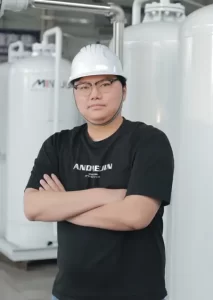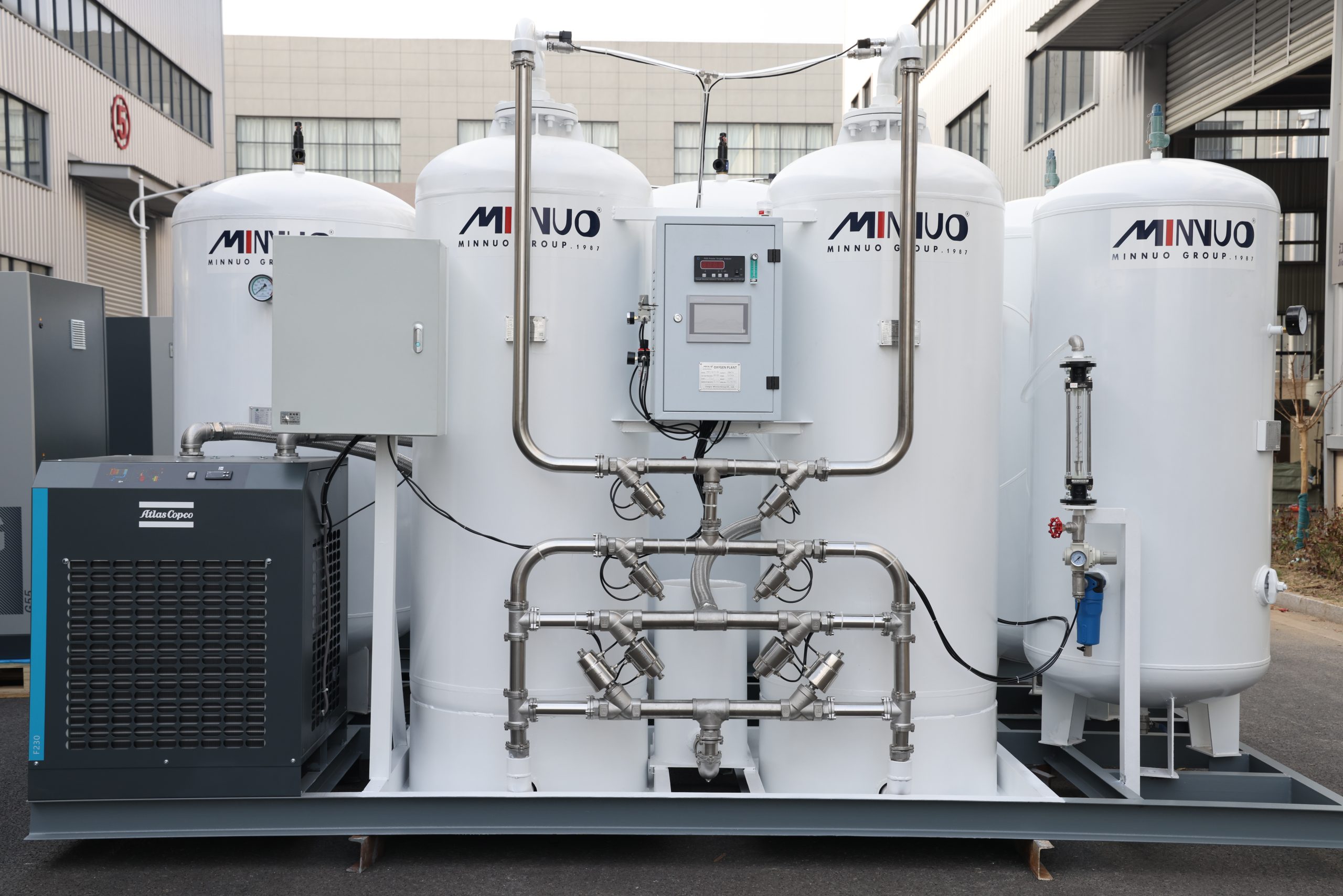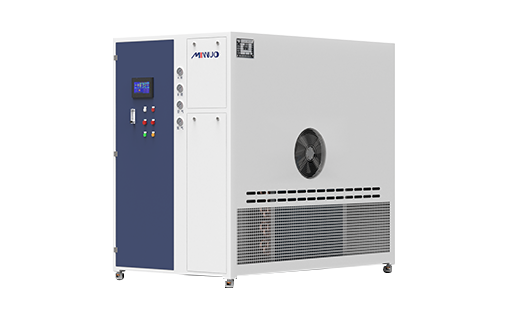PSA (Pressure Swing Adsorption) nitrogen generators, with their efficient and stable nitrogen production technology, are widely used in various industrial applications, especially in scenarios where large quantities of nitrogen are needed with continuous and stable supply. As a global leader in PSA nitrogen generator manufacturing, MINNUO is dedicated to providing high-quality, efficient nitrogen equipment to its customers. This article will provide a detailed guide on how to install a PSA nitrogen generator, including pre-installation preparation, system components, installation steps, safety precautions, and frequently asked questions.
When installing a PSA nitrogen generator, the first step is to select a suitable installation location, ensuring that the equipment has enough space and that the environment is dry and well-ventilated. Next, verify that the electrical and air supply meet the system requirements to ensure the stability of the electrical system and the compressed air system. Then, proceed with mechanical installation, electrical wiring, and pipe connections, followed by system commissioning and testing after installation. Finally, perform regular checks and maintenance to ensure long-term stable operation.

I. Pre-Installation Preparation for a PSA Nitrogen Generator
Before starting the installation of the PSA nitrogen generator, thorough preparation is essential. These preparation steps will help ensure a smooth installation process and optimize the system’s long-term operating efficiency.
1.1 Selecting the Right Installation Location
Choosing the right installation location is fundamental to ensuring the PSA nitrogen generator operates efficiently over the long term. Here are some recommendations when selecting the installation site:
- Space Requirements: Ensure the installation site has enough space to accommodate the PSA nitrogen generator and its associated equipment. Generally, a PSA system includes multiple components, such as compressors, air dryers, adsorption towers, control panels, and nitrogen storage tanks. Sufficient space should be left for each component to facilitate routine maintenance and inspections.
- Ventilation and Temperature: The installation location should provide good ventilation to avoid system overheating. PSA nitrogen generators typically operate best in an environment with temperatures ranging from 15°C to 35°C, avoiding extreme temperatures that could negatively affect system performance.
- Dry and Clean Environment: The installation environment should be kept dry to prevent moisture from affecting the system’s internal electronic components and the performance of the adsorption towers. The area around the equipment should be clean to prevent dust from entering the system, especially in compressed air pipelines and adsorption towers.
1.2 Electrical and Air Supply Preparation
PSA nitrogen generators require reliable electrical and compressed air supplies. Ensure the following equipment meets system requirements:
- Electrical Supply: Based on the power requirements of the equipment, confirm that the power voltage, current, and grounding system meet the equipment’s specifications. Typically, PSA nitrogen generators use a 380V or 480V three-phase power supply. Refer to the equipment’s technical manual for specific requirements.
- Compressed Air Supply: The main operating principle of PSA nitrogen generators is to use compressed air for nitrogen separation. Ensure the connected air compressor can provide the required airflow and pressure. The required compressed air flow is typically between 10 and 100 cubic meters per minute, with a pressure range of 6 to 8 bar.
- Air Drying: To ensure the proper operation of the adsorption tower, the system requires dry and clean compressed air. It is recommended to use a high-efficiency air dryer to prevent moisture from entering the system.
1.3 Safety and Regulatory Requirements
Safety is always the most important consideration during installation. Installation should comply with the relevant national or regional regulations, and the following requirements should be met:
- Electrical Safety: During installation, ensure that the electrical system and equipment are properly grounded to prevent electrical fires or shocks.
- Gas Leak Detection: During installation, check all connection points to ensure there are no gas leaks in the pipeline. Use appropriate gas detection instruments to detect leaks of nitrogen or compressed air.
- Fire Safety Equipment: Fire extinguishers and other fire safety equipment should be placed near the installation area to ensure that any potential fire hazards can be addressed promptly.
II. System Components and Functions of PSA Nitrogen Generators
A PSA nitrogen generator system typically consists of several key components, each with a specific function. Understanding the role of these components will help ensure that each part is properly installed and calibrated during the installation process.
2.1 Adsorption Tower
The adsorption tower is one of the core components of the PSA nitrogen generator. Its main function is to adsorb oxygen, water vapor, and carbon dioxide from the air using molecular sieve media, releasing pure nitrogen. PSA nitrogen generators typically use two or more adsorption towers to operate alternately, ensuring a continuous supply of nitrogen.
- Installation Requirements: The adsorption tower should be installed on a firm, stable foundation and should be protected from long-term exposure to moist environments to prevent the molecular sieve from being affected by moisture.
2.2 Air Compressor
The air compressor provides the compressed air required for the PSA system. Compressed air typically comes from the factory’s compressed air system but can also be supplied by a dedicated air compressor.
- Installation Requirements: Ensure that the air compressor’s flow rate and pressure meet the PSA nitrogen generator’s needs, and that the air entering the compressor has been processed by an efficient air dryer to minimize moisture content.
2.3 Air Dryer
The air dryer’s primary role is to remove moisture from the compressed air, preventing water from entering the adsorption tower and ensuring long-term, efficient operation of the molecular sieve.
- Installation Requirements: Ensure that the air dryer is tightly connected to the outlet of the compressor, and regularly clean the filters as needed.
2.4 Control Panel
The control panel is the “brain” of the PSA nitrogen generator, responsible for monitoring and controlling the system’s operation. It adjusts nitrogen purity, flow rates, and other parameters in real-time to ensure stable system operation.
- Installation Requirements: The control panel should be installed in a location that is convenient for operation and monitoring. Ensure correct cable connections and avoid long-term exposure to high temperatures or moisture.
2.5 Nitrogen Storage Tank
The nitrogen storage tank stores the nitrogen produced and supplies it to downstream pipeline systems through a pressure reduction device. The tank’s capacity should be selected based on the required nitrogen demand.
- Installation Requirements: The storage tank should be placed on stable ground and should not be exposed to direct sunlight or high-temperature environments for long periods.
III. Installation Steps for PSA Nitrogen Generators
After completing the preparatory work, the following are the detailed steps for installing the PSA nitrogen generator:
3.1 Mechanical Installation
- Install the Adsorption Tower: Place the adsorption tower at the designated location and ensure it is securely fixed. During installation, ensure the intake and exhaust pipes are properly connected to prevent gas leaks.
- Install the Air Compressor: Connect the air compressor to the adsorption tower through piping. Ensure all connections are secure and free from leaks.
- Install the Control Panel: Position the control panel in a convenient location for operation, ensuring correct cable connections and clear visibility of the interfaces.
- Install the Storage Tank: Place the nitrogen storage tank in an accessible location for maintenance and inspection, and connect the inlet and outlet pipes.
3.2 Electrical Wiring
Follow the electrical diagrams to connect the electrical system to the control panel. Ensure that cable connections are correct and the grounding system is reliable. Special attention should be given to ensuring the voltage, current, and grounding meet the equipment’s specifications when connecting the power supply.
3.3 Piping Connection
Ensure that the compressed air, nitrogen, and cooling pipelines are correctly connected. During installation, use high-quality pipe fittings and sealing materials to prevent leaks.
3.4 Commissioning and Testing
After all installations are complete, start the system for testing. Check the system’s pressure, nitrogen purity, flow rate, etc., to ensure they meet the required standards. If any abnormalities are found, stop the system immediately for inspection.
IV. Frequently Asked Questions (FAQ)
4.1 What size installation space is needed for a PSA nitrogen generator?
The required installation space for a PSA nitrogen generator depends on the model and configuration. Generally, the space should accommodate the equipment itself, pipelines, air compressor, and storage tank layout. It is recommended to leave sufficient space around the equipment for regular maintenance and inspection.
4.2 Can a PSA nitrogen generator operate in extreme weather conditions?
PSA nitrogen generators typically operate at ambient temperatures between 15°C and 35°C. Extreme cold or hot climates may affect the equipment’s performance. In such cases, it is recommended to install air conditioning or heating systems around the equipment to maintain optimal operating temperatures.
4.3 How to maintain and service a PSA nitrogen generator?
Regularly check the performance of the air compressor to ensure the cleanliness and dryness of the compressed air. Periodically replace the molecular sieves, check for airtightness, and ensure the equipment is leak-free. Additionally, regularly inspect the electrical system to prevent downtime due to electrical failures.
V. Conclusion
This article has provided a comprehensive guide on how to install a PSA nitrogen generator. The installation process includes detailed equipment selection, installation steps, and routine maintenance requirements. By following the correct procedure and ensuring regular maintenance, your PSA nitrogen generator will provide stable and efficient nitrogen supply to meet industrial production needs. As a professional manufacturer of PSA nitrogen generators, MINNUO will continue to provide high-quality products and services, ensuring your equipment remains in optimal working condition.






 sales2:+86 17506119168
sales2:+86 17506119168

